Integrated Pest Management of Helicoverpa armigera in Cotton Crops
VerifiedAdded on 2022/08/31
|29
|7106
|10
Report
AI Summary
This term paper examines Integrated Pest Management (IPM) practices to control Helicoverpa armigera, a major pest affecting cotton production in India, particularly in the southern regions. The paper details the pest's lifecycle, taxonomic classification, and the economic damage it inflicts. It explores various control methods, including cultural, biological, and chemical approaches, and the use of Economic Threshold Levels (ETL) and Economic Injury Levels (EIL) within an IPM framework. The report also discusses previous and current pest control methods, the importance of identifying and monitoring pests, and the application of strategic IPM approaches. The research draws on interviews with farmers, as well as books and journals. The paper highlights the significance of IPM in reducing input costs, and promoting sustainable cotton farming by focusing on IPM strategies for pest management.
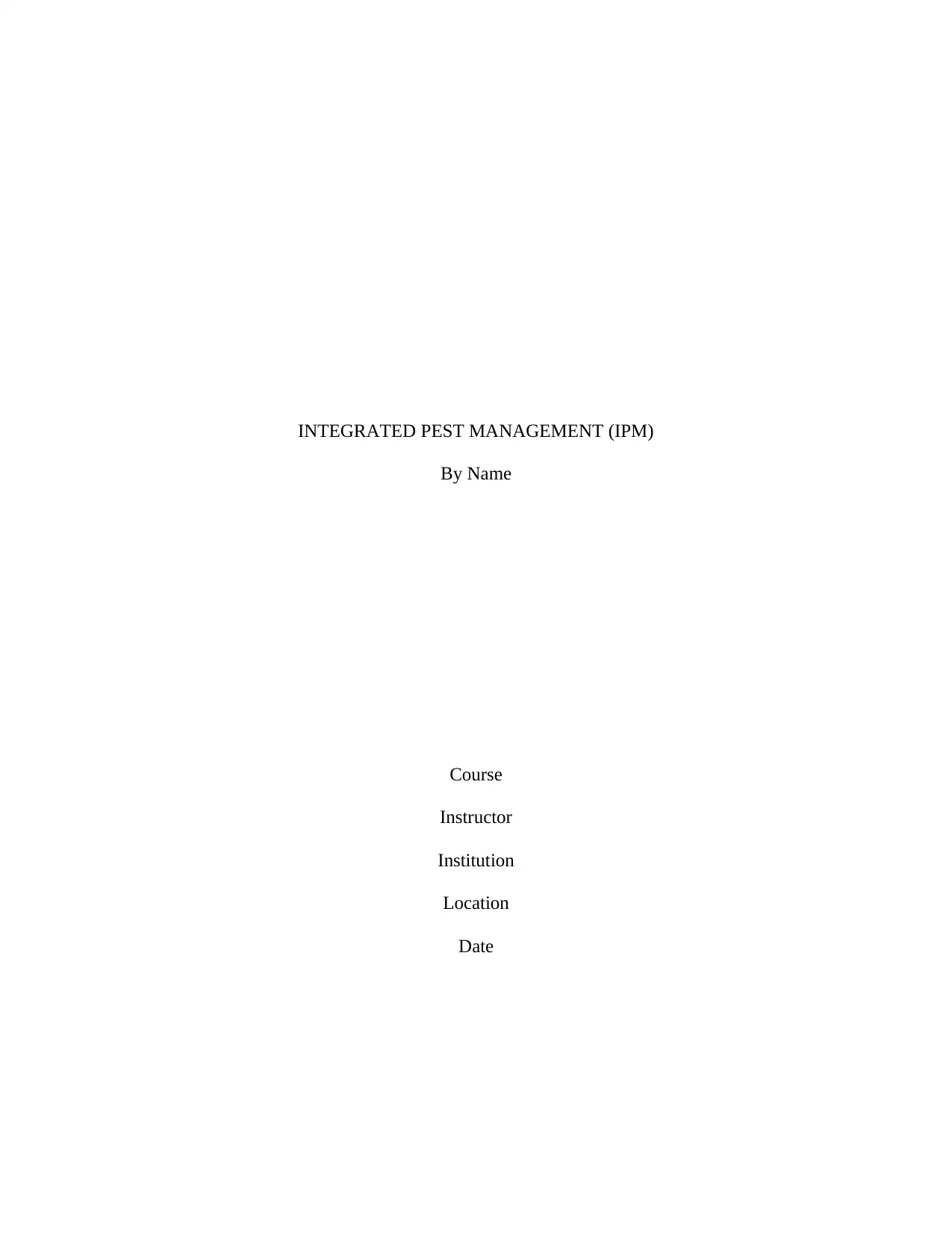
INTEGRATED PEST MANAGEMENT (IPM)
By Name
Course
Instructor
Institution
Location
Date
By Name
Course
Instructor
Institution
Location
Date
Paraphrase This Document
Need a fresh take? Get an instant paraphrase of this document with our AI Paraphraser
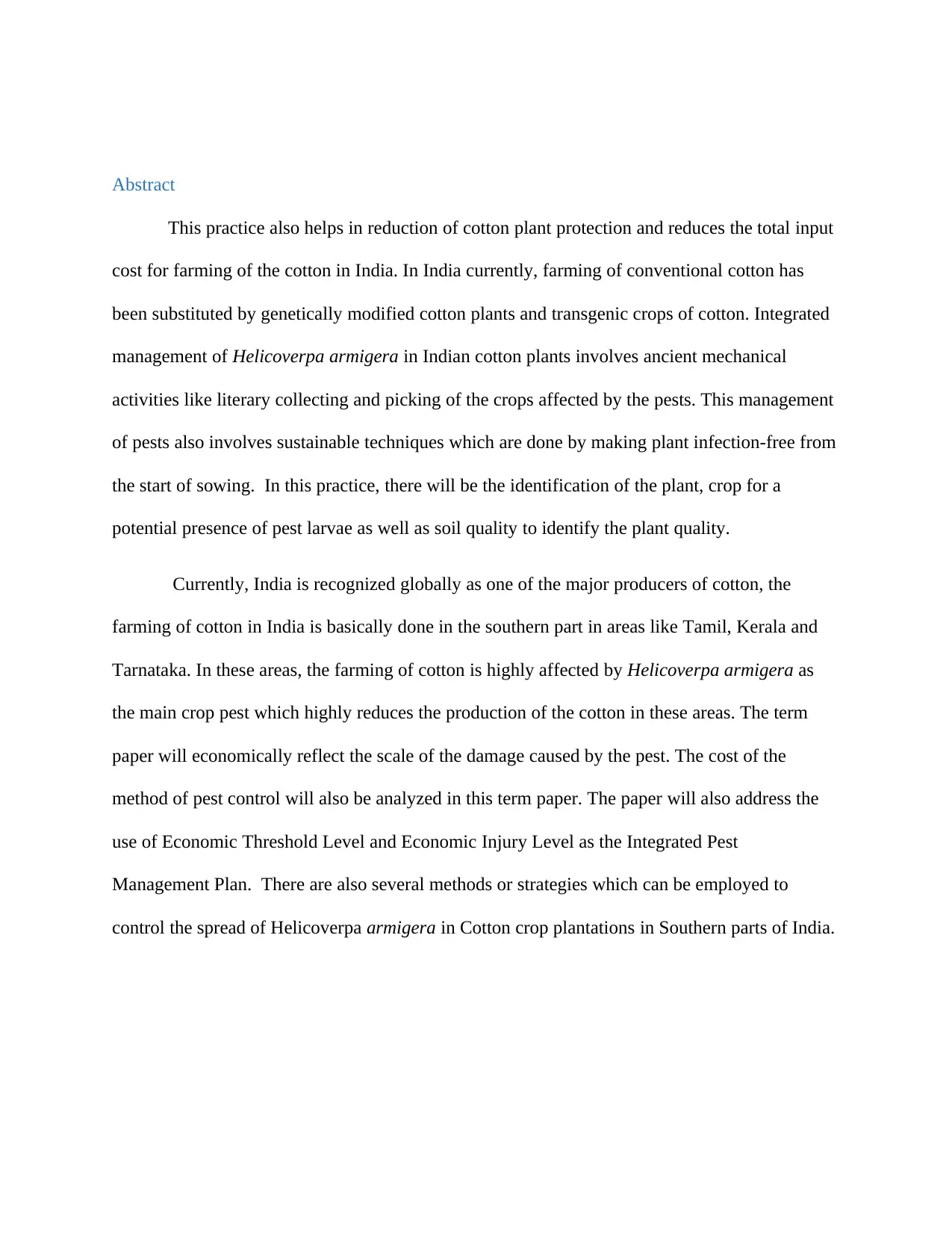
Abstract
This practice also helps in reduction of cotton plant protection and reduces the total input
cost for farming of the cotton in India. In India currently, farming of conventional cotton has
been substituted by genetically modified cotton plants and transgenic crops of cotton. Integrated
management of Helicoverpa armigera in Indian cotton plants involves ancient mechanical
activities like literary collecting and picking of the crops affected by the pests. This management
of pests also involves sustainable techniques which are done by making plant infection-free from
the start of sowing. In this practice, there will be the identification of the plant, crop for a
potential presence of pest larvae as well as soil quality to identify the plant quality.
Currently, India is recognized globally as one of the major producers of cotton, the
farming of cotton in India is basically done in the southern part in areas like Tamil, Kerala and
Tarnataka. In these areas, the farming of cotton is highly affected by Helicoverpa armigera as
the main crop pest which highly reduces the production of the cotton in these areas. The term
paper will economically reflect the scale of the damage caused by the pest. The cost of the
method of pest control will also be analyzed in this term paper. The paper will also address the
use of Economic Threshold Level and Economic Injury Level as the Integrated Pest
Management Plan. There are also several methods or strategies which can be employed to
control the spread of Helicoverpa armigera in Cotton crop plantations in Southern parts of India.
This practice also helps in reduction of cotton plant protection and reduces the total input
cost for farming of the cotton in India. In India currently, farming of conventional cotton has
been substituted by genetically modified cotton plants and transgenic crops of cotton. Integrated
management of Helicoverpa armigera in Indian cotton plants involves ancient mechanical
activities like literary collecting and picking of the crops affected by the pests. This management
of pests also involves sustainable techniques which are done by making plant infection-free from
the start of sowing. In this practice, there will be the identification of the plant, crop for a
potential presence of pest larvae as well as soil quality to identify the plant quality.
Currently, India is recognized globally as one of the major producers of cotton, the
farming of cotton in India is basically done in the southern part in areas like Tamil, Kerala and
Tarnataka. In these areas, the farming of cotton is highly affected by Helicoverpa armigera as
the main crop pest which highly reduces the production of the cotton in these areas. The term
paper will economically reflect the scale of the damage caused by the pest. The cost of the
method of pest control will also be analyzed in this term paper. The paper will also address the
use of Economic Threshold Level and Economic Injury Level as the Integrated Pest
Management Plan. There are also several methods or strategies which can be employed to
control the spread of Helicoverpa armigera in Cotton crop plantations in Southern parts of India.

Table of content
Abstract.......................................................................................................................................................2
Table of content..........................................................................................................................................3
Table of figures............................................................................................................................................4
List of tables................................................................................................................................................4
Background Information..............................................................................................................................5
Aim.............................................................................................................................................................5
An agricultural product, sourced from a plant or animal.............................................................................5
A geographic location..................................................................................................................................7
The suite of pests.........................................................................................................................................8
Major Cotton pests..................................................................................................................................9
Minor Cotton pests..................................................................................................................................9
American bollworm.................................................................................................................................9
Taxonomic of Helicoverpa armigera..................................................................................................9
Method......................................................................................................................................................10
Previous and current pest control methods................................................................................................10
Cultural control of American bollworm.................................................................................................12
Biological control of American bollworm.............................................................................................13
Chemical control of American bollworm..............................................................................................14
Economic threshold levels and economic injury levels with graphs..........................................................17
The Economic threshold levels.........................................................................................................17
Economic injury levels......................................................................................................................17
Missing information..................................................................................................................................22
References.................................................................................................................................................23
Abstract.......................................................................................................................................................2
Table of content..........................................................................................................................................3
Table of figures............................................................................................................................................4
List of tables................................................................................................................................................4
Background Information..............................................................................................................................5
Aim.............................................................................................................................................................5
An agricultural product, sourced from a plant or animal.............................................................................5
A geographic location..................................................................................................................................7
The suite of pests.........................................................................................................................................8
Major Cotton pests..................................................................................................................................9
Minor Cotton pests..................................................................................................................................9
American bollworm.................................................................................................................................9
Taxonomic of Helicoverpa armigera..................................................................................................9
Method......................................................................................................................................................10
Previous and current pest control methods................................................................................................10
Cultural control of American bollworm.................................................................................................12
Biological control of American bollworm.............................................................................................13
Chemical control of American bollworm..............................................................................................14
Economic threshold levels and economic injury levels with graphs..........................................................17
The Economic threshold levels.........................................................................................................17
Economic injury levels......................................................................................................................17
Missing information..................................................................................................................................22
References.................................................................................................................................................23
⊘ This is a preview!⊘
Do you want full access?
Subscribe today to unlock all pages.

Trusted by 1+ million students worldwide
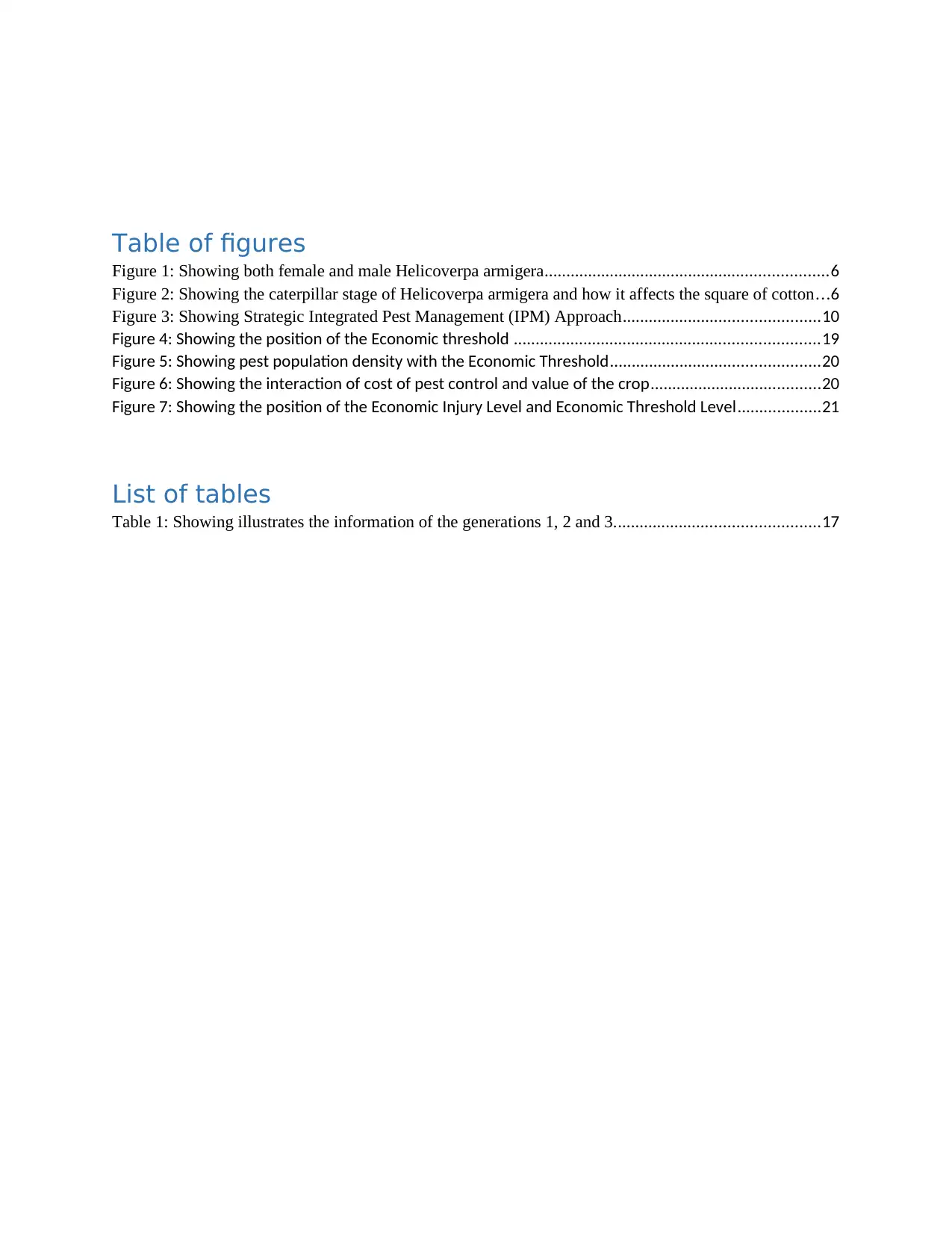
Table of figures
Figure 1: Showing both female and male Helicoverpa armigera.................................................................6
Figure 2: Showing the caterpillar stage of Helicoverpa armigera and how it affects the square of cotton...6
Figure 3: Showing Strategic Integrated Pest Management (IPM) Approach.............................................10
Figure 4: Showing the position of the Economic threshold ......................................................................19
Figure 5: Showing pest population density with the Economic Threshold................................................20
Figure 6: Showing the interaction of cost of pest control and value of the crop.......................................20
Figure 7: Showing the position of the Economic Injury Level and Economic Threshold Level...................21
List of tables
Table 1: Showing illustrates the information of the generations 1, 2 and 3...............................................17
Figure 1: Showing both female and male Helicoverpa armigera.................................................................6
Figure 2: Showing the caterpillar stage of Helicoverpa armigera and how it affects the square of cotton...6
Figure 3: Showing Strategic Integrated Pest Management (IPM) Approach.............................................10
Figure 4: Showing the position of the Economic threshold ......................................................................19
Figure 5: Showing pest population density with the Economic Threshold................................................20
Figure 6: Showing the interaction of cost of pest control and value of the crop.......................................20
Figure 7: Showing the position of the Economic Injury Level and Economic Threshold Level...................21
List of tables
Table 1: Showing illustrates the information of the generations 1, 2 and 3...............................................17
Paraphrase This Document
Need a fresh take? Get an instant paraphrase of this document with our AI Paraphraser
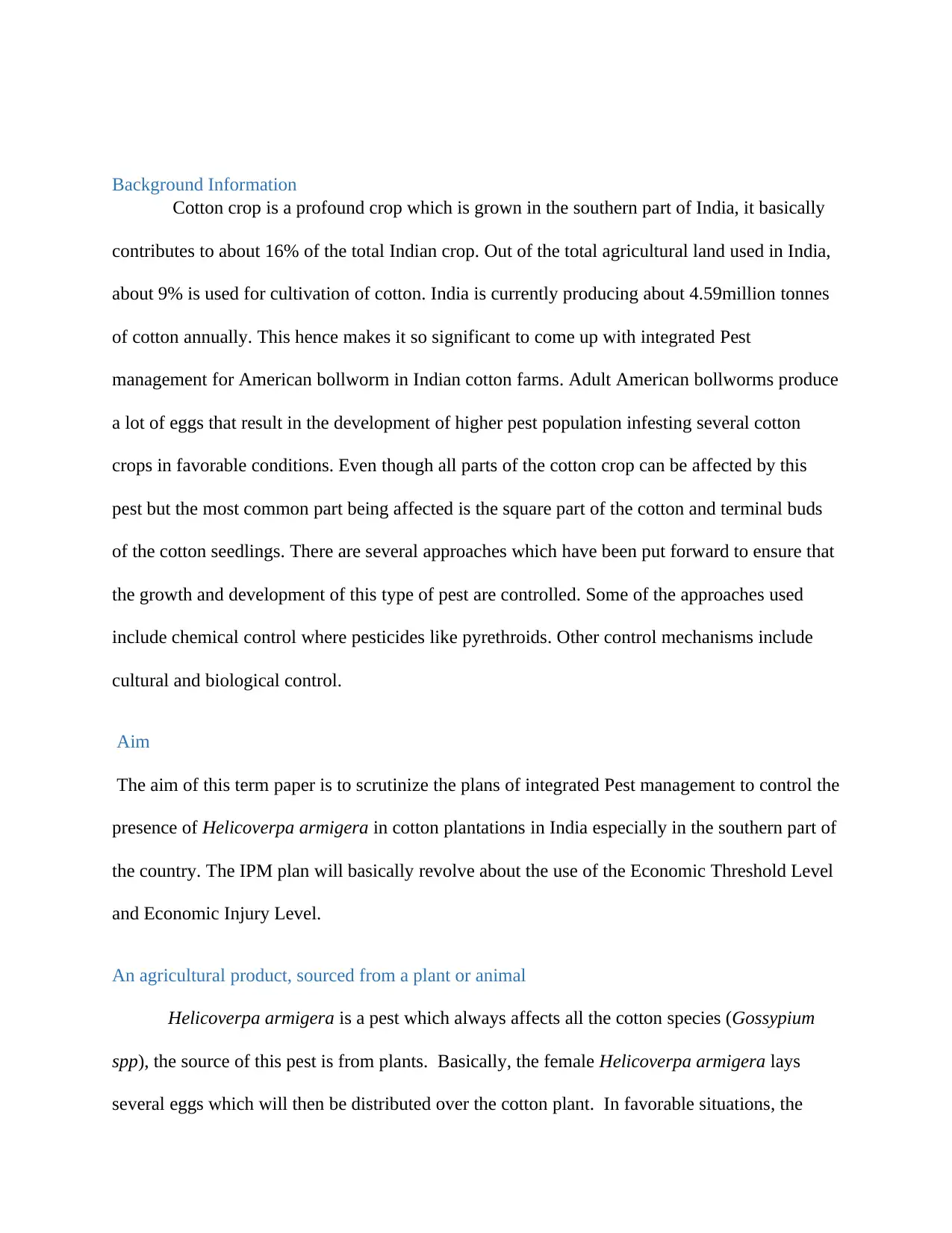
Background Information
Cotton crop is a profound crop which is grown in the southern part of India, it basically
contributes to about 16% of the total Indian crop. Out of the total agricultural land used in India,
about 9% is used for cultivation of cotton. India is currently producing about 4.59million tonnes
of cotton annually. This hence makes it so significant to come up with integrated Pest
management for American bollworm in Indian cotton farms. Adult American bollworms produce
a lot of eggs that result in the development of higher pest population infesting several cotton
crops in favorable conditions. Even though all parts of the cotton crop can be affected by this
pest but the most common part being affected is the square part of the cotton and terminal buds
of the cotton seedlings. There are several approaches which have been put forward to ensure that
the growth and development of this type of pest are controlled. Some of the approaches used
include chemical control where pesticides like pyrethroids. Other control mechanisms include
cultural and biological control.
Aim
The aim of this term paper is to scrutinize the plans of integrated Pest management to control the
presence of Helicoverpa armigera in cotton plantations in India especially in the southern part of
the country. The IPM plan will basically revolve about the use of the Economic Threshold Level
and Economic Injury Level.
An agricultural product, sourced from a plant or animal
Helicoverpa armigera is a pest which always affects all the cotton species (Gossypium
spp), the source of this pest is from plants. Basically, the female Helicoverpa armigera lays
several eggs which will then be distributed over the cotton plant. In favorable situations, the
Cotton crop is a profound crop which is grown in the southern part of India, it basically
contributes to about 16% of the total Indian crop. Out of the total agricultural land used in India,
about 9% is used for cultivation of cotton. India is currently producing about 4.59million tonnes
of cotton annually. This hence makes it so significant to come up with integrated Pest
management for American bollworm in Indian cotton farms. Adult American bollworms produce
a lot of eggs that result in the development of higher pest population infesting several cotton
crops in favorable conditions. Even though all parts of the cotton crop can be affected by this
pest but the most common part being affected is the square part of the cotton and terminal buds
of the cotton seedlings. There are several approaches which have been put forward to ensure that
the growth and development of this type of pest are controlled. Some of the approaches used
include chemical control where pesticides like pyrethroids. Other control mechanisms include
cultural and biological control.
Aim
The aim of this term paper is to scrutinize the plans of integrated Pest management to control the
presence of Helicoverpa armigera in cotton plantations in India especially in the southern part of
the country. The IPM plan will basically revolve about the use of the Economic Threshold Level
and Economic Injury Level.
An agricultural product, sourced from a plant or animal
Helicoverpa armigera is a pest which always affects all the cotton species (Gossypium
spp), the source of this pest is from plants. Basically, the female Helicoverpa armigera lays
several eggs which will then be distributed over the cotton plant. In favorable situations, the
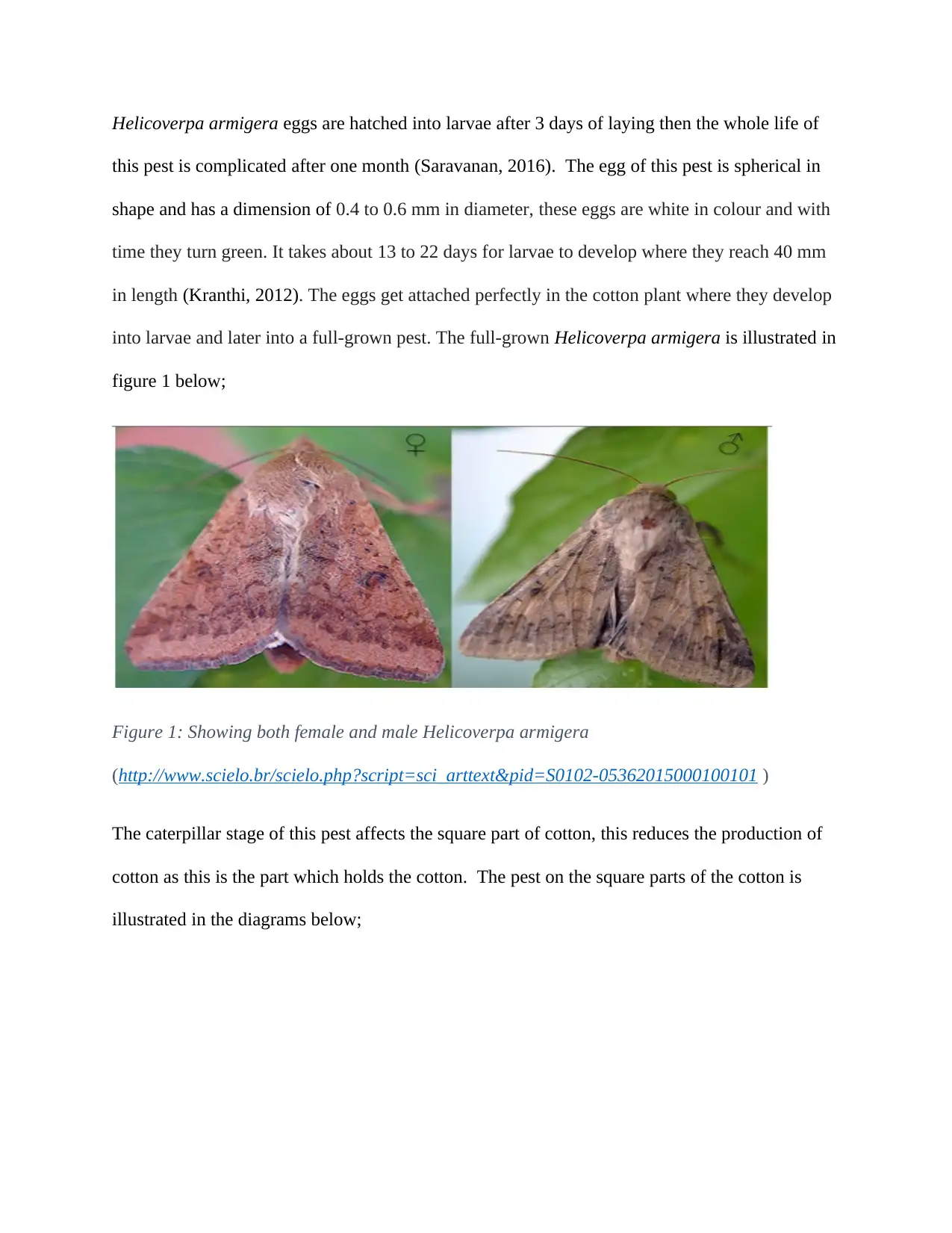
Helicoverpa armigera eggs are hatched into larvae after 3 days of laying then the whole life of
this pest is complicated after one month (Saravanan, 2016). The egg of this pest is spherical in
shape and has a dimension of 0.4 to 0.6 mm in diameter, these eggs are white in colour and with
time they turn green. It takes about 13 to 22 days for larvae to develop where they reach 40 mm
in length (Kranthi, 2012). The eggs get attached perfectly in the cotton plant where they develop
into larvae and later into a full-grown pest. The full-grown Helicoverpa armigera is illustrated in
figure 1 below;
Figure 1: Showing both female and male Helicoverpa armigera
(http://www.scielo.br/scielo.php?script=sci_arttext&pid=S0102-05362015000100101 )
The caterpillar stage of this pest affects the square part of cotton, this reduces the production of
cotton as this is the part which holds the cotton. The pest on the square parts of the cotton is
illustrated in the diagrams below;
this pest is complicated after one month (Saravanan, 2016). The egg of this pest is spherical in
shape and has a dimension of 0.4 to 0.6 mm in diameter, these eggs are white in colour and with
time they turn green. It takes about 13 to 22 days for larvae to develop where they reach 40 mm
in length (Kranthi, 2012). The eggs get attached perfectly in the cotton plant where they develop
into larvae and later into a full-grown pest. The full-grown Helicoverpa armigera is illustrated in
figure 1 below;
Figure 1: Showing both female and male Helicoverpa armigera
(http://www.scielo.br/scielo.php?script=sci_arttext&pid=S0102-05362015000100101 )
The caterpillar stage of this pest affects the square part of cotton, this reduces the production of
cotton as this is the part which holds the cotton. The pest on the square parts of the cotton is
illustrated in the diagrams below;
⊘ This is a preview!⊘
Do you want full access?
Subscribe today to unlock all pages.

Trusted by 1+ million students worldwide
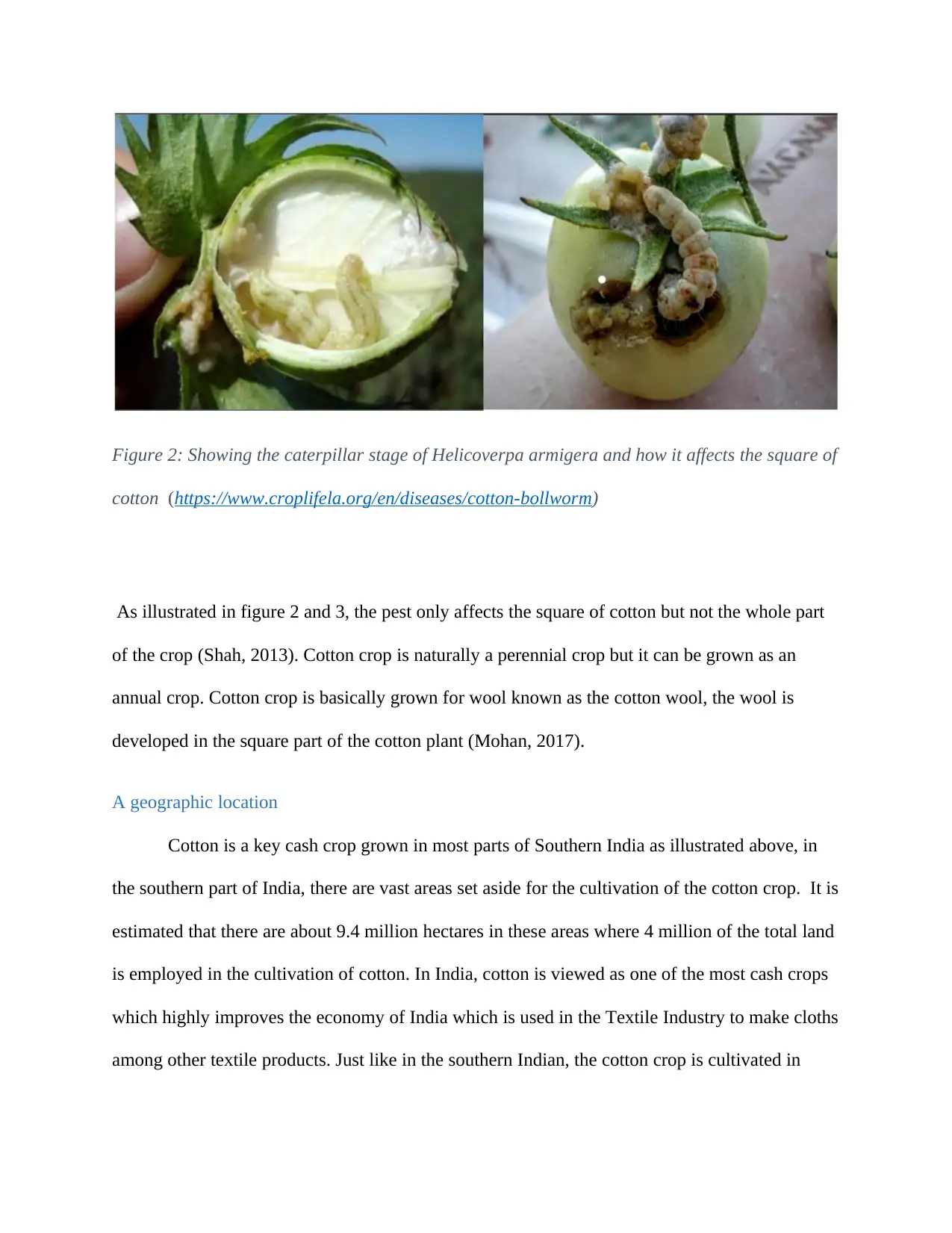
Figure 2: Showing the caterpillar stage of Helicoverpa armigera and how it affects the square of
cotton (https://www.croplifela.org/en/diseases/cotton-bollworm)
As illustrated in figure 2 and 3, the pest only affects the square of cotton but not the whole part
of the crop (Shah, 2013). Cotton crop is naturally a perennial crop but it can be grown as an
annual crop. Cotton crop is basically grown for wool known as the cotton wool, the wool is
developed in the square part of the cotton plant (Mohan, 2017).
A geographic location
Cotton is a key cash crop grown in most parts of Southern India as illustrated above, in
the southern part of India, there are vast areas set aside for the cultivation of the cotton crop. It is
estimated that there are about 9.4 million hectares in these areas where 4 million of the total land
is employed in the cultivation of cotton. In India, cotton is viewed as one of the most cash crops
which highly improves the economy of India which is used in the Textile Industry to make cloths
among other textile products. Just like in the southern Indian, the cotton crop is cultivated in
cotton (https://www.croplifela.org/en/diseases/cotton-bollworm)
As illustrated in figure 2 and 3, the pest only affects the square of cotton but not the whole part
of the crop (Shah, 2013). Cotton crop is naturally a perennial crop but it can be grown as an
annual crop. Cotton crop is basically grown for wool known as the cotton wool, the wool is
developed in the square part of the cotton plant (Mohan, 2017).
A geographic location
Cotton is a key cash crop grown in most parts of Southern India as illustrated above, in
the southern part of India, there are vast areas set aside for the cultivation of the cotton crop. It is
estimated that there are about 9.4 million hectares in these areas where 4 million of the total land
is employed in the cultivation of cotton. In India, cotton is viewed as one of the most cash crops
which highly improves the economy of India which is used in the Textile Industry to make cloths
among other textile products. Just like in the southern Indian, the cotton crop is cultivated in
Paraphrase This Document
Need a fresh take? Get an instant paraphrase of this document with our AI Paraphraser

subtropical and tropical regions since this crop needs a relatively higher temperature of about
220C to 310C.
In this geographical location, cotton is grown in black soil in Malwa plateau. India
cultivates a variety of cotton over edaphic and climatic conditions from sub-montane tract in
Tinnevelly district of Tamil Nadu located in the southern part of India (Krishna, 2012).
Basically, cotton thrives best arid area where the rainfall is less than 75 cm. The soil in these
areas where the cotton is grown is a sticky black of Deccan Trap having a higher moisture
retaining capacity (Abrol, 2012). Cotton is seen as a long staple in India when fibre is 2.2 cm or
more, it is considered a medium staple when the length of tearing fibre falls between 1.7 and 2.2
cm and it is considered a short-staple variety when fibre length is below 1.7 cm (Ahuja, 2012).
In these southern areas in India, Kerala produces the least quantity of cotton while areas like
Tamil Nadu, Karnataka and Andhra Pradesh produce a lot of cotton (Tabashnik, 2010). Most of
these parts of south India are below 1500 meters above the sea level which highly favors the
growth of cotton.
The suite of pests
Apart from Helicoverpa armigera which highly affects the cotton crop, this pest
specifically affects the square part of the cotton (the part which holds cotton) there are other
pests which affects the growth and production of the cotton crop (Borkhani, 2011). These pests
are classified as major and minor, major pests are those which are highly common and
predominantly affects cotton (their effect on cotton is severe) while the minor are those pests
whose impact on the cotton is not that serious and they are not common (Luttrell, 2015). Below
are some of the example of the major and the minor pests affecting the growth and production of
cotton in the southern part of India (Balakrishnan, 2010).
220C to 310C.
In this geographical location, cotton is grown in black soil in Malwa plateau. India
cultivates a variety of cotton over edaphic and climatic conditions from sub-montane tract in
Tinnevelly district of Tamil Nadu located in the southern part of India (Krishna, 2012).
Basically, cotton thrives best arid area where the rainfall is less than 75 cm. The soil in these
areas where the cotton is grown is a sticky black of Deccan Trap having a higher moisture
retaining capacity (Abrol, 2012). Cotton is seen as a long staple in India when fibre is 2.2 cm or
more, it is considered a medium staple when the length of tearing fibre falls between 1.7 and 2.2
cm and it is considered a short-staple variety when fibre length is below 1.7 cm (Ahuja, 2012).
In these southern areas in India, Kerala produces the least quantity of cotton while areas like
Tamil Nadu, Karnataka and Andhra Pradesh produce a lot of cotton (Tabashnik, 2010). Most of
these parts of south India are below 1500 meters above the sea level which highly favors the
growth of cotton.
The suite of pests
Apart from Helicoverpa armigera which highly affects the cotton crop, this pest
specifically affects the square part of the cotton (the part which holds cotton) there are other
pests which affects the growth and production of the cotton crop (Borkhani, 2011). These pests
are classified as major and minor, major pests are those which are highly common and
predominantly affects cotton (their effect on cotton is severe) while the minor are those pests
whose impact on the cotton is not that serious and they are not common (Luttrell, 2015). Below
are some of the example of the major and the minor pests affecting the growth and production of
cotton in the southern part of India (Balakrishnan, 2010).
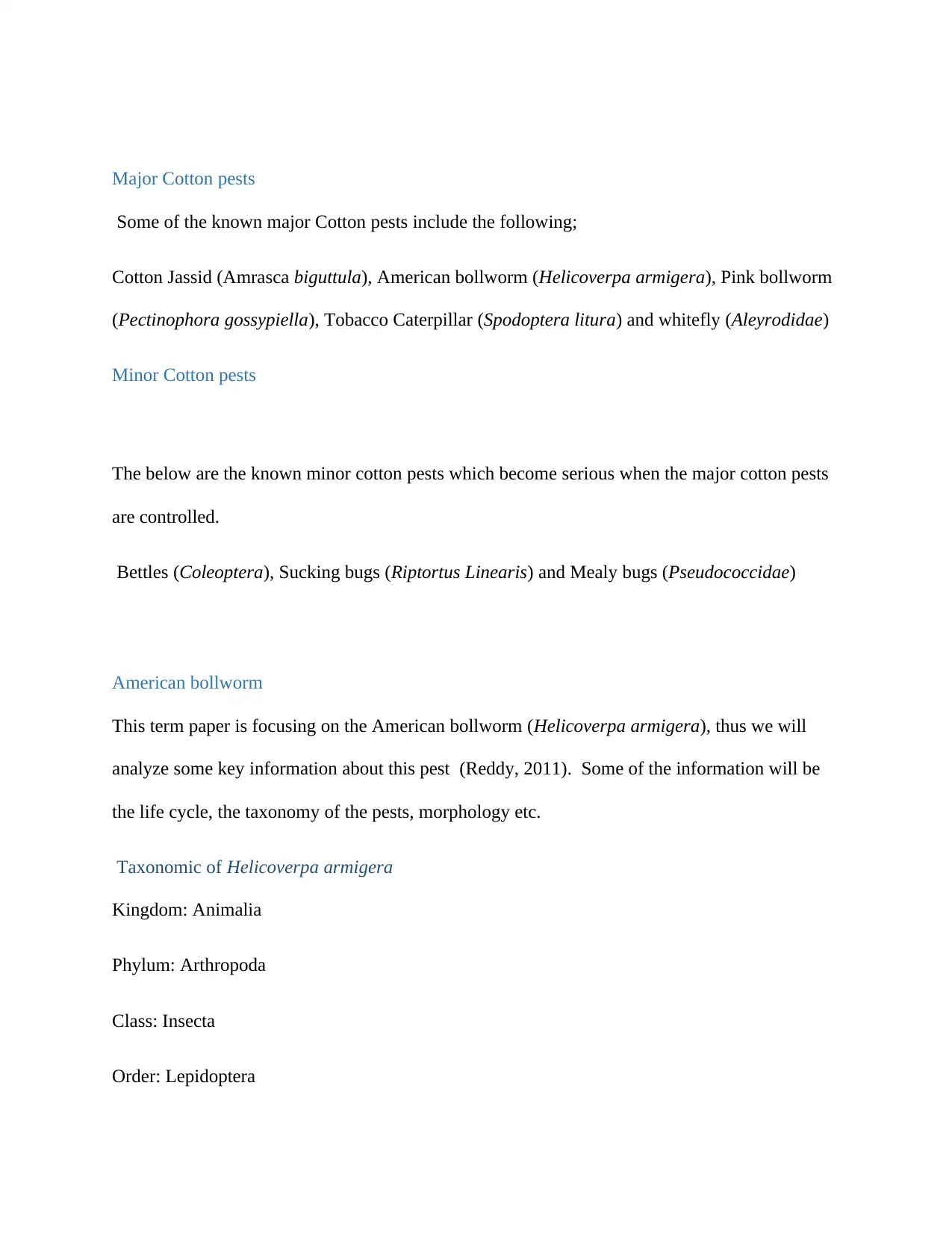
Major Cotton pests
Some of the known major Cotton pests include the following;
Cotton Jassid (Amrasca biguttula), American bollworm (Helicoverpa armigera), Pink bollworm
(Pectinophora gossypiella), Tobacco Caterpillar (Spodoptera litura) and whitefly (Aleyrodidae)
Minor Cotton pests
The below are the known minor cotton pests which become serious when the major cotton pests
are controlled.
Bettles (Coleoptera), Sucking bugs (Riptortus Linearis) and Mealy bugs (Pseudococcidae)
American bollworm
This term paper is focusing on the American bollworm (Helicoverpa armigera), thus we will
analyze some key information about this pest (Reddy, 2011). Some of the information will be
the life cycle, the taxonomy of the pests, morphology etc.
Taxonomic of Helicoverpa armigera
Kingdom: Animalia
Phylum: Arthropoda
Class: Insecta
Order: Lepidoptera
Some of the known major Cotton pests include the following;
Cotton Jassid (Amrasca biguttula), American bollworm (Helicoverpa armigera), Pink bollworm
(Pectinophora gossypiella), Tobacco Caterpillar (Spodoptera litura) and whitefly (Aleyrodidae)
Minor Cotton pests
The below are the known minor cotton pests which become serious when the major cotton pests
are controlled.
Bettles (Coleoptera), Sucking bugs (Riptortus Linearis) and Mealy bugs (Pseudococcidae)
American bollworm
This term paper is focusing on the American bollworm (Helicoverpa armigera), thus we will
analyze some key information about this pest (Reddy, 2011). Some of the information will be
the life cycle, the taxonomy of the pests, morphology etc.
Taxonomic of Helicoverpa armigera
Kingdom: Animalia
Phylum: Arthropoda
Class: Insecta
Order: Lepidoptera
⊘ This is a preview!⊘
Do you want full access?
Subscribe today to unlock all pages.

Trusted by 1+ million students worldwide
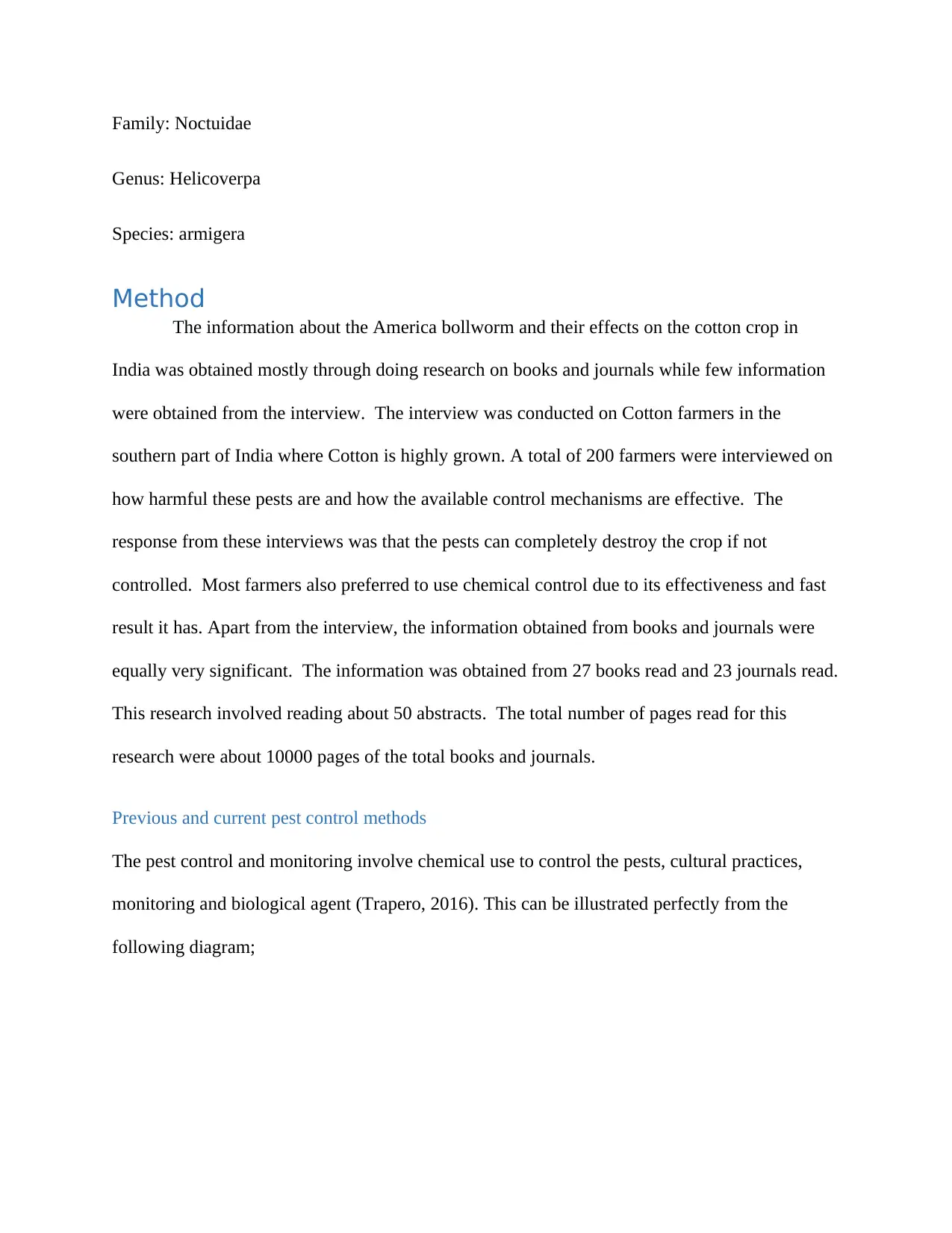
Family: Noctuidae
Genus: Helicoverpa
Species: armigera
Method
The information about the America bollworm and their effects on the cotton crop in
India was obtained mostly through doing research on books and journals while few information
were obtained from the interview. The interview was conducted on Cotton farmers in the
southern part of India where Cotton is highly grown. A total of 200 farmers were interviewed on
how harmful these pests are and how the available control mechanisms are effective. The
response from these interviews was that the pests can completely destroy the crop if not
controlled. Most farmers also preferred to use chemical control due to its effectiveness and fast
result it has. Apart from the interview, the information obtained from books and journals were
equally very significant. The information was obtained from 27 books read and 23 journals read.
This research involved reading about 50 abstracts. The total number of pages read for this
research were about 10000 pages of the total books and journals.
Previous and current pest control methods
The pest control and monitoring involve chemical use to control the pests, cultural practices,
monitoring and biological agent (Trapero, 2016). This can be illustrated perfectly from the
following diagram;
Genus: Helicoverpa
Species: armigera
Method
The information about the America bollworm and their effects on the cotton crop in
India was obtained mostly through doing research on books and journals while few information
were obtained from the interview. The interview was conducted on Cotton farmers in the
southern part of India where Cotton is highly grown. A total of 200 farmers were interviewed on
how harmful these pests are and how the available control mechanisms are effective. The
response from these interviews was that the pests can completely destroy the crop if not
controlled. Most farmers also preferred to use chemical control due to its effectiveness and fast
result it has. Apart from the interview, the information obtained from books and journals were
equally very significant. The information was obtained from 27 books read and 23 journals read.
This research involved reading about 50 abstracts. The total number of pages read for this
research were about 10000 pages of the total books and journals.
Previous and current pest control methods
The pest control and monitoring involve chemical use to control the pests, cultural practices,
monitoring and biological agent (Trapero, 2016). This can be illustrated perfectly from the
following diagram;
Paraphrase This Document
Need a fresh take? Get an instant paraphrase of this document with our AI Paraphraser
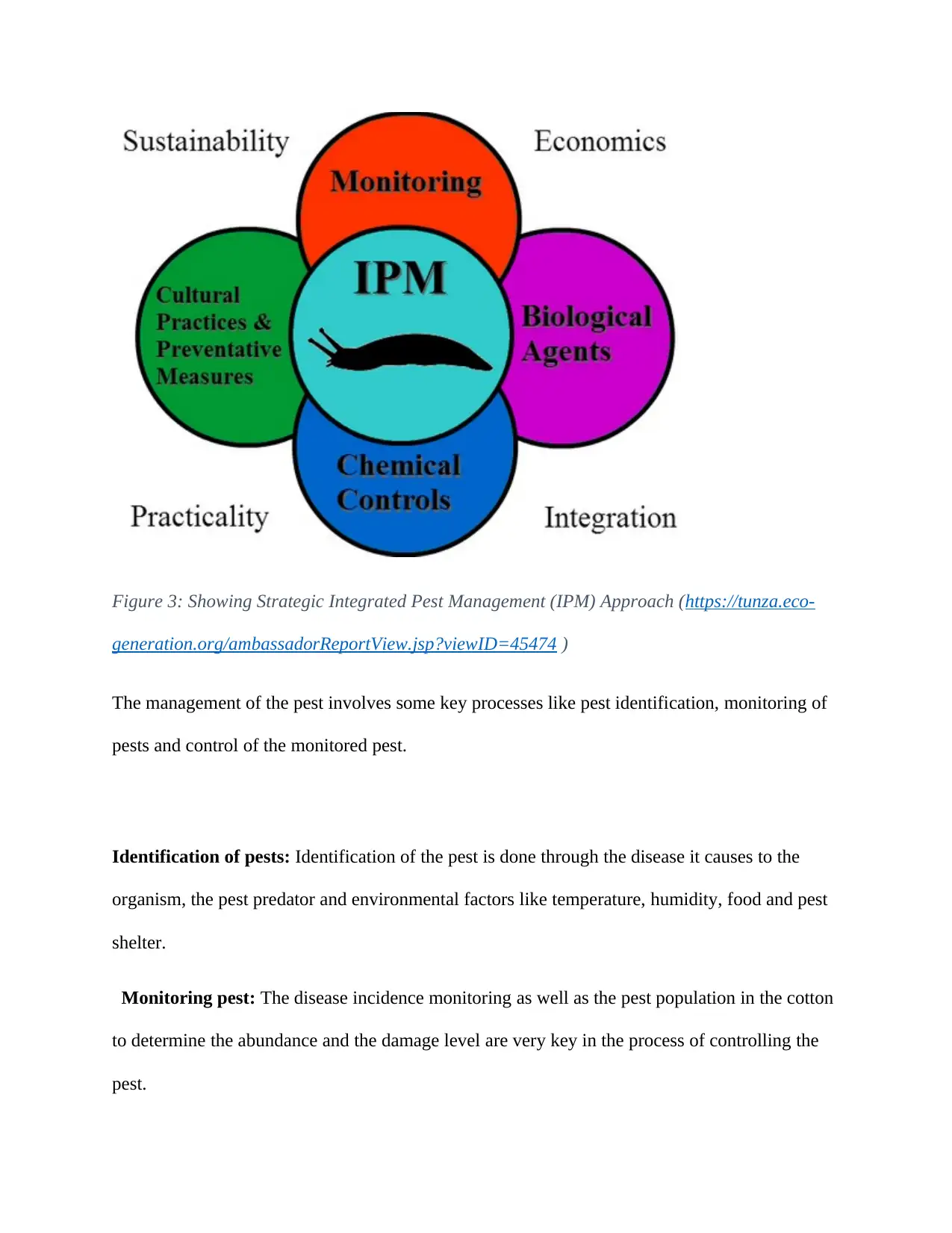
Figure 3: Showing Strategic Integrated Pest Management (IPM) Approach (https://tunza.eco-
generation.org/ambassadorReportView.jsp?viewID=45474 )
The management of the pest involves some key processes like pest identification, monitoring of
pests and control of the monitored pest.
Identification of pests: Identification of the pest is done through the disease it causes to the
organism, the pest predator and environmental factors like temperature, humidity, food and pest
shelter.
Monitoring pest: The disease incidence monitoring as well as the pest population in the cotton
to determine the abundance and the damage level are very key in the process of controlling the
pest.
generation.org/ambassadorReportView.jsp?viewID=45474 )
The management of the pest involves some key processes like pest identification, monitoring of
pests and control of the monitored pest.
Identification of pests: Identification of the pest is done through the disease it causes to the
organism, the pest predator and environmental factors like temperature, humidity, food and pest
shelter.
Monitoring pest: The disease incidence monitoring as well as the pest population in the cotton
to determine the abundance and the damage level are very key in the process of controlling the
pest.

Some of these methods of controlling pests include the following
Cultural control of American bollworm
Trap planting and trap cropping are vastly acknowledged as the cultural control method
which has been employed to control this pest for a long period of time now (Prasad, 2016). For
cotton plantation, sorghum and maize diversionary host have a very short attractive period for
supporting the population of the crop (Masood, 2011). Some researchers have emphasized the
significance of ploughing cotton stubble to reduce the burden of the population for parathyroid
resistance of American bollworm (Mazid, 2011). There are several cultural practices which have
been used as a management strategy to lower chances of survival of American bollworm like the
application of fertilizers, spacing, deep ploughing and sowing time (Khan, 2015). Post-harvest
cultivation is also applied to help in the destruction of the pupea of the pest has received
attention in bollworm population management.
The pest pupea can also be destroyed through employing cultivation of Cotton at a depth
of 10 cm. When this pupea is destroyed it becomes difficult for them to emerge from the tunnels
and develop into a moth. Using a deep ploughing during the summer seasons aids in exposing
the bollworm pests which are pathogens and soil born (Khadi, 2011). The exposure of these
pathogens aids in their destruction thus reducing their number in the cotton plantation. Another
cultural practice which has been in practice for a long period to control the spread of bollworm in
cotton is crop rotation (Singh, 2016). Cotton is highly rotated with some crops like sorghum and
maize. The use of crop rotation as a cultural method is so significant in Indian agriculture
because it not only results in pest control but also increases the yield of crops being rotated like
cotton, sorghum and maize (Chandel, 2010). Crop extension or double cropping plays a very
significant role in ensuring that the spread of the pest is highly curtailed (Hutchison, 2015)
Cultural control of American bollworm
Trap planting and trap cropping are vastly acknowledged as the cultural control method
which has been employed to control this pest for a long period of time now (Prasad, 2016). For
cotton plantation, sorghum and maize diversionary host have a very short attractive period for
supporting the population of the crop (Masood, 2011). Some researchers have emphasized the
significance of ploughing cotton stubble to reduce the burden of the population for parathyroid
resistance of American bollworm (Mazid, 2011). There are several cultural practices which have
been used as a management strategy to lower chances of survival of American bollworm like the
application of fertilizers, spacing, deep ploughing and sowing time (Khan, 2015). Post-harvest
cultivation is also applied to help in the destruction of the pupea of the pest has received
attention in bollworm population management.
The pest pupea can also be destroyed through employing cultivation of Cotton at a depth
of 10 cm. When this pupea is destroyed it becomes difficult for them to emerge from the tunnels
and develop into a moth. Using a deep ploughing during the summer seasons aids in exposing
the bollworm pests which are pathogens and soil born (Khadi, 2011). The exposure of these
pathogens aids in their destruction thus reducing their number in the cotton plantation. Another
cultural practice which has been in practice for a long period to control the spread of bollworm in
cotton is crop rotation (Singh, 2016). Cotton is highly rotated with some crops like sorghum and
maize. The use of crop rotation as a cultural method is so significant in Indian agriculture
because it not only results in pest control but also increases the yield of crops being rotated like
cotton, sorghum and maize (Chandel, 2010). Crop extension or double cropping plays a very
significant role in ensuring that the spread of the pest is highly curtailed (Hutchison, 2015)
⊘ This is a preview!⊘
Do you want full access?
Subscribe today to unlock all pages.

Trusted by 1+ million students worldwide
1 out of 29
Your All-in-One AI-Powered Toolkit for Academic Success.
+13062052269
info@desklib.com
Available 24*7 on WhatsApp / Email
![[object Object]](/_next/static/media/star-bottom.7253800d.svg)
Unlock your academic potential
Copyright © 2020–2025 A2Z Services. All Rights Reserved. Developed and managed by ZUCOL.